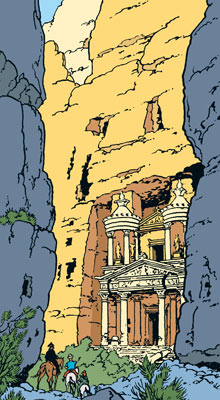At the peer assessment I was encouraged to introduce more of a hand-drawn edge to the illustrations, which I agree would add more character. I was enjoying using Photoshop for the illustrations as that is a new style for me, but completing my Independent Study on typography in picture books has given me a passion for hand-lettering and hand-created illustration. For these reasons I have remade the idea by hand.
I tried to recreate the image by hand as well as possible, while adding a rough and imperfect style to the lined illustrations and finishing with a watercolour wash. This effect worked better than I thought it would and the uneven, mottled affect works well on the green areas and not too badly on the sky where it gives the impression of clouds.
In the top-left hand corner of the page I have recreated the banner on an old paper effect, titling the page 'Peru', while underneath is an old, worn, explorer's map showing more of the location. One of the pointers from the group session was that on the computer this style seemed to be aimed at an older age range than the genre of the picture book suggests but hand-drawn I think it is more suitable.
One major change to the story and the notes supplied by Gyles Morris is that it is no longer a balloon ride around the world but a paper plane instead. I feel this could add an interactive element to the book, where the child could play along and make their own paper plane which I will play around with earlier in the book.
The basic layout is the same and a similar style of worn paper will be used to explain the elements of the Peruvian country to continue the theme of exploration throughout. In the bottom corner is an introduction to the next pages of the book, which uses more colours than the explorers map style, where the reader can learn to make their own Peruvian headdress. I feel this would separate the activities from the information and make the book clearer to the child.
These designs are possibles for the new cover to follow with the different story. The title has to change, and I think it will be 'Paper Plane Explorer' which explains clearly the style of the book, but another option is 'Chocks Away' which is a famous aviation expression. I will continue the worn paper style here too but only as an addition to the main style as it may make the book look more grown up and appeal to the wrong age group.
The typography, and use of hand-lettering, will hopefully reinforce the idea that the story is for younger children as it tends to be used mostly in children's picture books for children around the age of 6.
This is a design for the other spread. Initially I was planning to illustrate the page following the layout for Peru, and show the reader how to create a headdress and make an Andean pattern. However, I think it would be more appropriate to design the first spread from the book, encouraging the reader to make a paper plane and introduce the story, while providing an extra sheet of paper to be used on the paper plane.

























